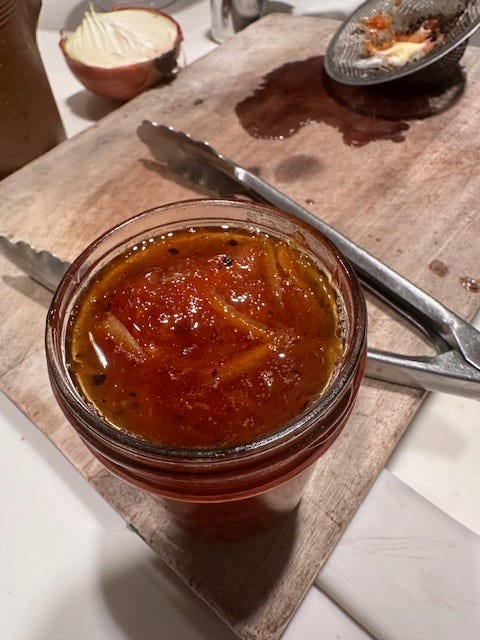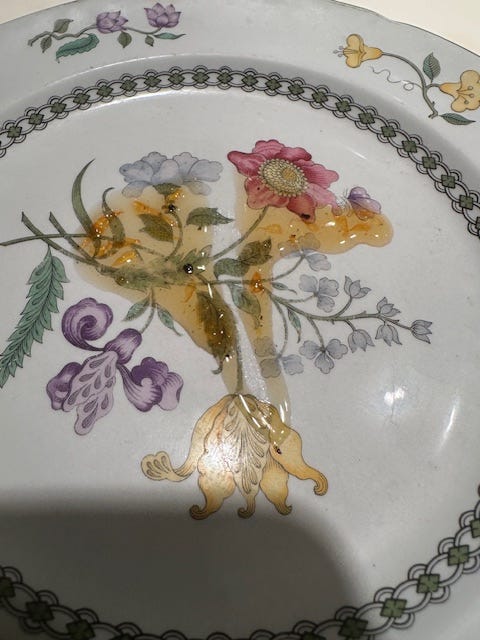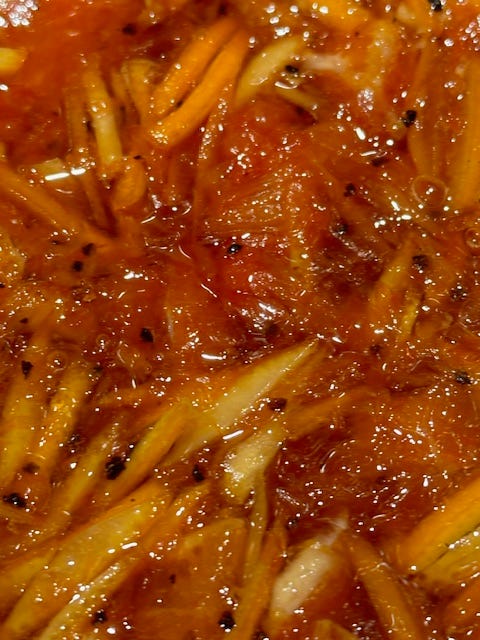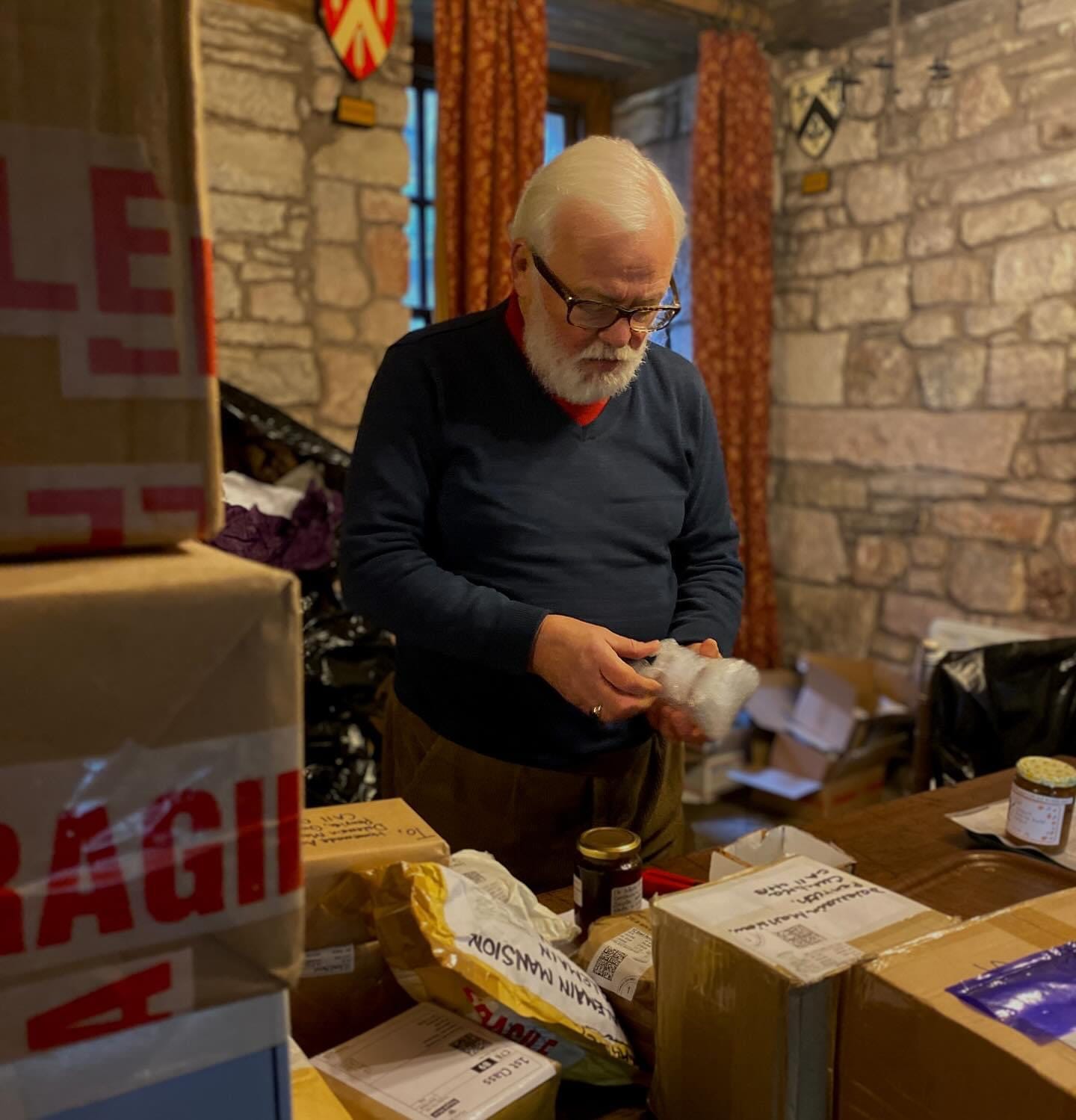BITES&NIBBLES May 2024
A Marmalade Contest, an Olympic-like Event
story, recipe + photography by BRANDA ATHANUS
It was early January—with its short days and cold, windy weather outside. I took my copper cauldron off its kitchen rack and polished it like a brand-new penny. ‘We’ were getting ready to make Chai Three Citrus marmalade for the Dalemain World Marmalade Awards.
That’s what I decided to make for the Dalemain Marmalade Awards in Cumbria, in the northwest lake region of England near the Scottish border.
I’ve always wanted to be part of ‘The Marmalade Peeps’ from all over the globe. There are two divisions: ‘Homemade’ and ‘Artisan Professional’, which have 12 categories each, take your choice. I picked citrus marmalade with tea, non-professional. The grand winner of the Professional judging gets to have a massive display at Fortnum & Mason in downtown London, an honor that must give you pause as each customer grabs at least one jar, or many. Just how fast can you julienne citrus peels and fill thousands of jars to keep that mountain of marmalade, well, mountainous?
I choose the non-professional division to maintain my sanity and each jar would be judged by tenured marmalade experts, plus the bonus was that I would receive tasting notes from the judges—what they liked, what they didn’t. How wonderful to be critiqued from the best judges. All the entrance fees are donated to Hospice of the United Kingdom, a great charity to support.
A good thing to be part of … Marmalade People are my kind of people.
My marmalade odyssey starts by choosing the fruit—red grapefruits, Cara Cara oranges and limes—all organic for good reason because to be the star of the show, it must be the best fruit possible. It’s important to pick fruit that looks perky and
fresh, and plump and heavy.
Start by washing and lightly scrubbing the fruits with a brush to remove the food-grade wax from the outside, then dry them. Next, use a very sharp knife, either a paring knife or a chef’s knife, whatever your comfort level is. Peel off only the rind versus the pith—the white thick protective layer between the outer peel and the fruit. When all the peel is removed the laborious task of julienning begins. This takes a fair amount of time, especially when you are entering your marmalade into a ‘world-class’ event.
Not too long, not too thick and not too thin, perfect two-inch long julienned pieces, an 1/8-inch thick and thousands of them. This task requires a large pot of tea, concentration and love of the process.
I couldn’t stop smiling.
A heavy hour later, I had a bowl of thread-sized, julienned peel in a delicate yellow, electric orange and just enough bright green, just waiting to be immortalized in a jar destined for a competition in a distant land.
Now, for the remainder of fruit: The pith is rich with pectin which gels, or as they say, ‘sets’ the marmalade. Cut the pith into chunks and place it on a double layer of cheesecloth. Next, remove the fruit sections from the membrane and place them in another bowl. Make sure to find all the seeds and put them into the cheesecloth along with the membrane and pith—this is what thickens marmalade.
I like to precook/blanch my peel because I don’t like too bitter a finished marmalade. Some recipes cook everything altogether, but I do mine in steps to manage the bitterness. I cover the peels with cold water and bring it almost to a boil, then drain the water and repeat. The peel should be almost cooked, but retaining its texture, not too soft. It will cook further along with the fruit, the tied-up cheesecloth bag and sugar.
Because I was making a Chai-enhanced marmalade, I gathered all the whole spices and ground them in a mortar and pestle coarsely—I wanted to see them in the finished product and if ground too fine they would make the marmalade less clear.
I used cinnamon stick, cloves, cardamom, fresh peeled and grated ginger and a touch of black pepper.
The last prep was sterilizing the jam jars, covering them with boiling water and leaving them in hot water while I started to cook.
In my wide copper jam pot, I placed my drained peels, the fruit sections and the filled cheesecloth bag, which I tied to one of the pot’s handles for easy retrieval when it’s time to remove it. Next, add fresh water, almost to the top of the mixture and bury the cheesecloth bag down into the fruit.
Showtime: Turn on the heat, low and slow. Use your favorite wooden spoon and enjoy the process and the aroma wafting all around.
As it simmers, the water will turn orange as it cooks down and the whole mixture will become translucent. The transformation is beginning. I always press the cheesecloth bundle with the back of my wooden spoon and give the whole mixture a little jiggle.
This is the time to put the two small bread plates into the freezer to
deep chill. This is the oldest method of determining when the marmalade is done, and its foolproof. As it reduces, I decide when to add the Chai spices. I don’t want them cooking too long with the fruit and altering their fresh spicy punch. Just before I add the sugar would be ideal. In they go, and I stirred. They looked exactly like I imagined.
Now for the big taste test … It didn’t taste like what I had imagined.
I had a bag of Chai black tea in my pantry and that was the flavor I was trying to achieve—a more balanced spice taste, with the color of steeped tea. I added it slowly, a light tablespoon and stirred, and sniffed and tasted. That was the right direction. I added another teaspoon and the color transformed to a beautiful copper with dots of long black tea leaves and spices in suspension.
It's sugar time.
The Rule of Marmalade is 4 cups sugar to 4 cups fruit. Yes and no is my answer, that’s just a formula because you must adapt to variables—like tart fruit, sour fruit and sweetness are deeply personal. Measure out all the sugar, but hold back a cup to adjust the sweetness.
Check your small plates in the freezer, are they chilled? Jars are still in hot water? Have you measured the sugar and have extra on the side?
Turn on the heat to medium or medium low, the hotter the faster, the lower the slower. Bring mixture to a robust boil, add less than the full amount of sugar, stir
well, press on the cheesecloth bag, and monitor the mixture with a thermometer.
The magic temperature to make marmalade is 220F degrees. Watch it carefully, stir regularly so it doesn’t go sailing past the important number of 220F.
Is it sweet enough? Does it need a little more sugar, Now is the time to TASTE, DECIDE and ADJUST.
As the aroma intensifies and the color changes, the boiling bubbles will thicken as the marmalade becomes more concentrated. With experience, you can tell by how the mixture drops from your wooden spoon, but I still use the frozen plate test as well.
Drop a tablespoon of the boiling mixture onto a frozen plate, wait about ten seconds and run your finger through the center. Does the gape fill back in? If it does, it’s not ready and needs more cooking time. The thermometer is essential, but there are surprises and sometimes you’ll want a softer textured marmalade.
The minute you hit the target temperature, and you like the way it reacts on the frozen plate, remove the pot from the burner so it starts to cool. Squeeze the cheesecloth bag like you would do with a used tea bag, discard, and stir the mixture well. I wait about ten minutes, so the peel/fruit plumps up and is equally distributed as the mixture thickens. Ladle into hot jars, clean the rims, cover and process in boiling water for 10 minutes. Marmalade must age for 30 days to mellow and meld together.
The Dalemain Marmalade entrees must be postmarked by February 5th at 5:00pm and at the end of April they have a large gathering of marmalade lovers and makers in a beautiful countryside town at a manor house during the peak of spring flowers. The town decorates their trees with sliced, dried oranges, orange lights, flags and every known book and pamphlets on citrus and marmalade making around the world.
Every morning, after the start of the judging, I got up to check their website as the entrees arrived from all over the world. There, I saw a picture of all the boxes that had arrived the day before the 5th.
Was that my writing on the box about to be opened? Well, indeed it was!
And now I wait…
It’s not winning that is most important to me, it’s the whole process, from start to finish and getting to share my passion for GOOD marmalade with 3,000 other contestants.
It has been an incredible experience and as I imagined, I’m with ‘My Peeps.’
………………………………………………………
GO BRENDA!!!
Enjoy!
Nancy
nancy.zestmaine@gmail.com
pillowinks.com
P.S. I just published my first children’s coloring book … They arrive from the printer on Thursday. Never thought I could do this … So exciting!





